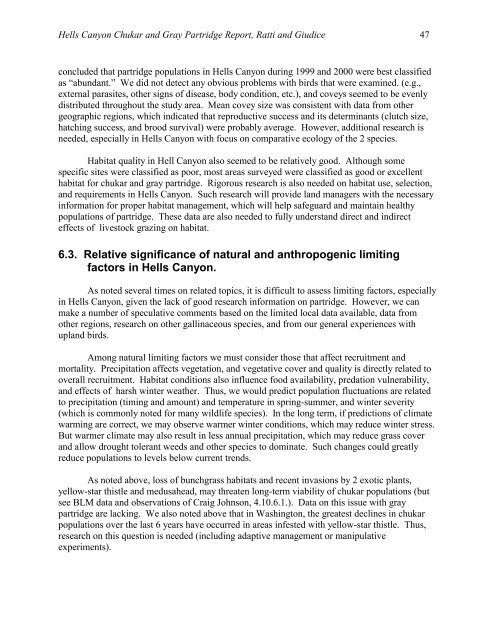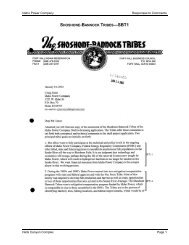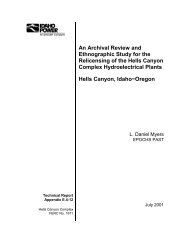Assessment of Chukar and Gray Partridge Populations - Idaho Power
Assessment of Chukar and Gray Partridge Populations - Idaho Power
Assessment of Chukar and Gray Partridge Populations - Idaho Power
- No tags were found...
Create successful ePaper yourself
Turn your PDF publications into a flip-book with our unique Google optimized e-Paper software.
Hells Canyon <strong>Chukar</strong> <strong>and</strong> <strong>Gray</strong> <strong>Partridge</strong> Report, Ratti <strong>and</strong> Giudice 47concluded that partridge populations in Hells Canyon during 1999 <strong>and</strong> 2000 were best classifiedas “abundant.” We did not detect any obvious problems with birds that were examined. (e.g.,external parasites, other signs <strong>of</strong> disease, body condition, etc.), <strong>and</strong> coveys seemed to be evenlydistributed throughout the study area. Mean covey size was consistent with data from othergeographic regions, which indicated that reproductive success <strong>and</strong> its determinants (clutch size,hatching success, <strong>and</strong> brood survival) were probably average. However, additional research isneeded, especially in Hells Canyon with focus on comparative ecology <strong>of</strong> the 2 species.Habitat quality in Hell Canyon also seemed to be relatively good. Although somespecific sites were classified as poor, most areas surveyed were classified as good or excellenthabitat for chukar <strong>and</strong> gray partridge. Rigorous research is also needed on habitat use, selection,<strong>and</strong> requirements in Hells Canyon. Such research will provide l<strong>and</strong> managers with the necessaryinformation for proper habitat management, which will help safeguard <strong>and</strong> maintain healthypopulations <strong>of</strong> partridge. These data are also needed to fully underst<strong>and</strong> direct <strong>and</strong> indirecteffects <strong>of</strong> livestock grazing on habitat.6.3. Relative significance <strong>of</strong> natural <strong>and</strong> anthropogenic limitingfactors in Hells Canyon.As noted several times on related topics, it is difficult to assess limiting factors, especiallyin Hells Canyon, given the lack <strong>of</strong> good research information on partridge. However, we canmake a number <strong>of</strong> speculative comments based on the limited local data available, data fromother regions, research on other gallinaceous species, <strong>and</strong> from our general experiences withupl<strong>and</strong> birds.Among natural limiting factors we must consider those that affect recruitment <strong>and</strong>mortality. Precipitation affects vegetation, <strong>and</strong> vegetative cover <strong>and</strong> quality is directly related tooverall recruitment. Habitat conditions also influence food availability, predation vulnerability,<strong>and</strong> effects <strong>of</strong> harsh winter weather. Thus, we would predict population fluctuations are relatedto precipitation (timing <strong>and</strong> amount) <strong>and</strong> temperature in spring-summer, <strong>and</strong> winter severity(which is commonly noted for many wildlife species). In the long term, if predictions <strong>of</strong> climatewarming are correct, we may observe warmer winter conditions, which may reduce winter stress.But warmer climate may also result in less annual precipitation, which may reduce grass cover<strong>and</strong> allow drought tolerant weeds <strong>and</strong> other species to dominate. Such changes could greatlyreduce populations to levels below current trends.As noted above, loss <strong>of</strong> bunchgrass habitats <strong>and</strong> recent invasions by 2 exotic plants,yellow-star thistle <strong>and</strong> medusahead, may threaten long-term viability <strong>of</strong> chukar populations (butsee BLM data <strong>and</strong> observations <strong>of</strong> Craig Johnson, 4.10.6.1.). Data on this issue with graypartridge are lacking. We also noted above that in Washington, the greatest declines in chukarpopulations over the last 6 years have occurred in areas infested with yellow-star thistle. Thus,research on this question is needed (including adaptive management or manipulativeexperiments).
















